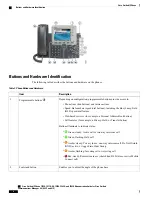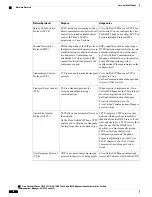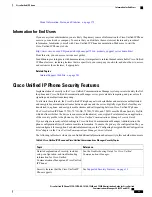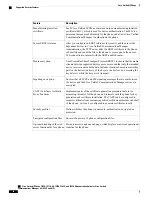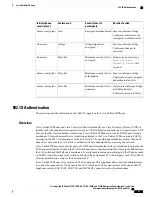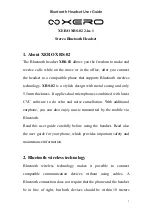
Usage notes
Purpose
Network protocol
The Cisco Unified IP Phone uses CDP
to communicate information such as
auxiliary VLAN ID, per port power
management details, and Quality of
Service (QoS) configuration information
with the Cisco Catalyst switch.
CDP is a device-discovery protocol
that runs on all Cisco-manufactured
equipment.
By using CDP, a device can advertise
its existence to other devices and
receive information about other
devices in the network.
Cisco Discovery Protocol
(CDP)
The Peer Firmware Sharing feature uses
CPPDP.
CPPDP is a Cisco proprietary protocol
that forms a-peer-to-peer hierarchy of
devices. CPPDP also copies firmware
or other files from peer devices to
neighboring devices.
Cisco Peer-to-Peer
Distribution Protocol
(CPPDP)
DHCP is enabled by default. If disabled,
you must manually configure the IP
address, subnet mask, gateway, and a
TFTP server on each phone locally.
Cisco recommends that you use DHCP
custom option 150. With this method,
you configure the TFTP server IP
address as the option value. For
additional supported DHCP
configurations, see the
“
Dynamic Host
Configuration Protocol
”
and
“
Cisco TFTP
”
chapters in the
Cisco Unified Communications Manager
System Guide
.
DHCP dynamically allocates and
assigns an IP address to network
devices.
DHCP enables you to connect an IP
phone into the network and have the
phone become operational without the
need to assign an IP address manually
or to configure additional network
parameters.
Dynamic Host
Configuration Protocol
(DHCP)
Cisco Unified IP Phones use HTTP for
XML services and for troubleshooting
purposes. The phones use HTTP to
download configuration files and
firmware loads. If the HTTP download
fails, the phone uses TFTP to transfer
the files.
Cisco Unified IP Phones do not support
the use of IPv6 addresses in the URL.
You cannot use a literal IPv6 address in
the URL or a hostname that maps to an
IPv6 address.
HTTP is the standard way of
transferring information and moving
documents across the Internet and the
web.
Hypertext Transfer
Protocol (HTTP)
Web applications with both HTTP and
HTTPS support have two URLs
configured. For a Cisco Unified IP
Phone that supports HTTPS, choose the
HTTPS URL from the two URLs.
Hypertext Transfer Protocol Secure
(HTTPS) is a combination of the
Hypertext Transfer Protocol with the
SSL/TLS protocol to provide
encryption and secure identification
of servers.
Hypertext Transfer
Protocol Secure (HTTPS)
Cisco Unified IP Phone 7975G, 7971G-GE, 7970G, 7965G, and 7945G Administration Guide for Cisco Unified
Communications Manager 9.0 (SCCP and SIP)
7
Cisco Unified IP Phone
Network Protocols












